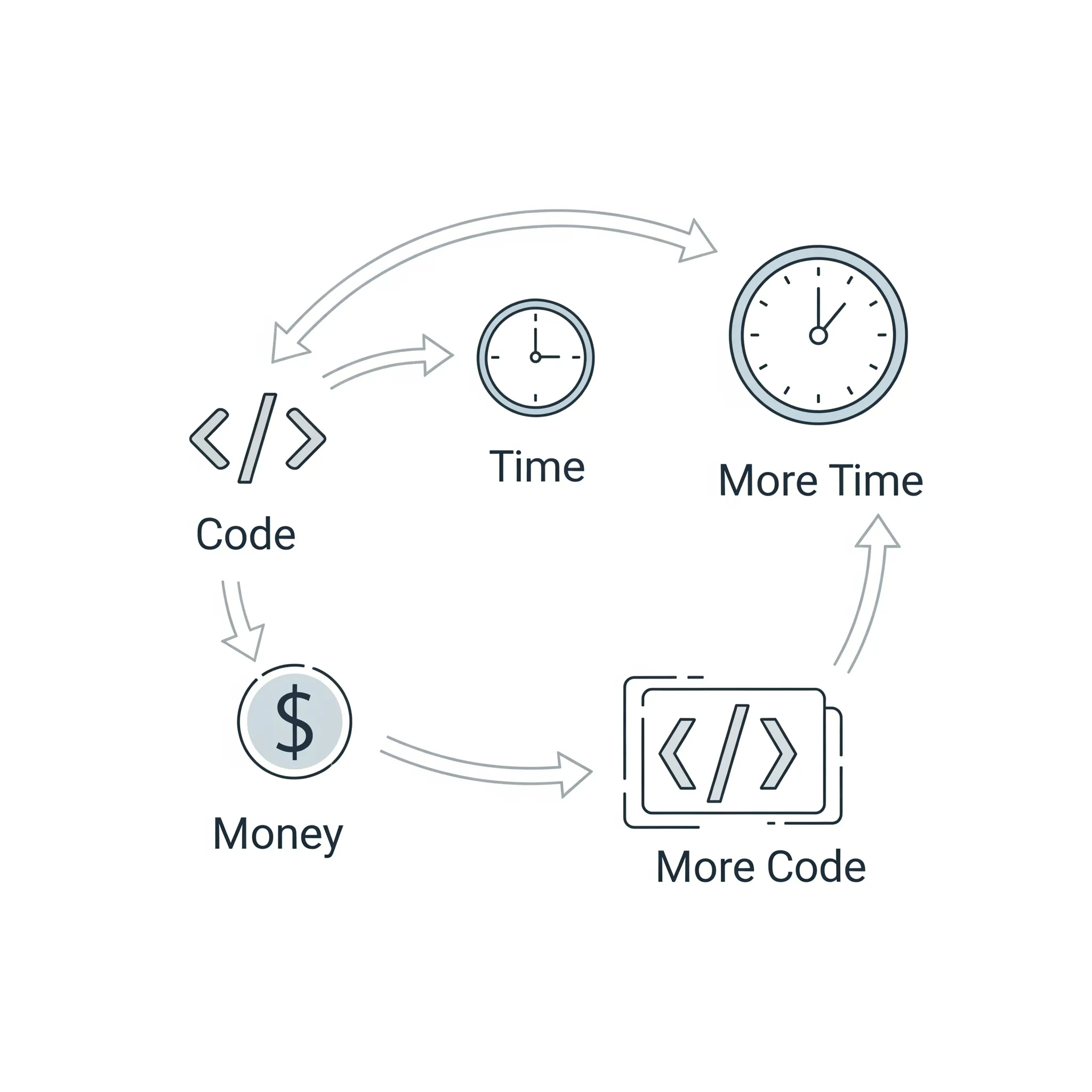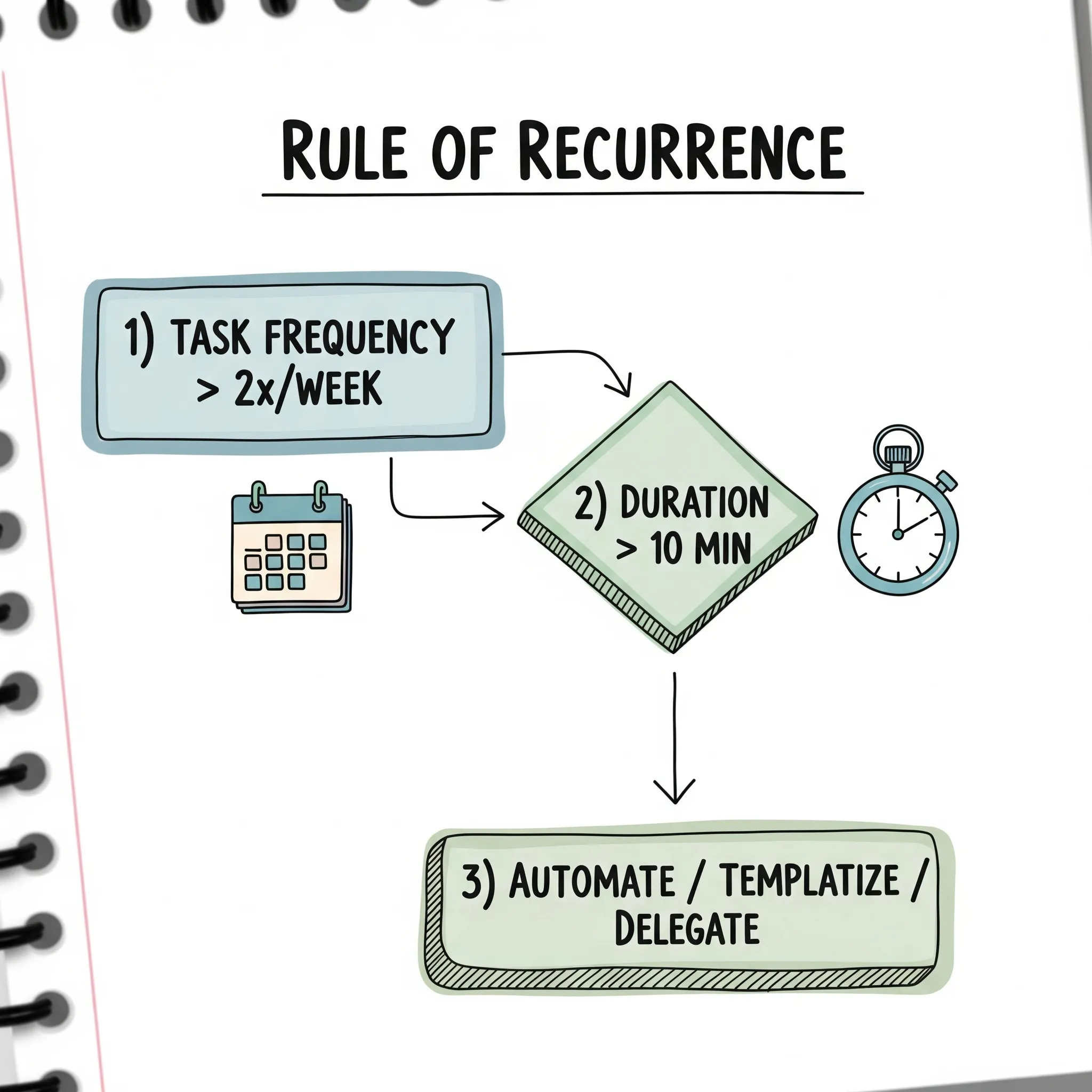There’s a quiet kind of magic in building systems that work harder than you do. I first felt it when I wrote a basic script that organized my inbox—just a few lines that sorted incoming messages into folders based on subject or sender. It took 20 minutes to build. It saved me ten minutes a day. Over a year, that’s more than 60 hours handed back to me.
That tiny win became the first link in a bigger feedback loop—something I now think of as the compounding loop. It’s simple in concept, but deceptively powerful:
Code → Time → Money → More Code → More Time...
Each part feeds the next. Write a script or build a tool? You save time. Use that time to learn, build, or earn? You grow your income or skills. Use those gains to build better tools? You loop back stronger. Like compound interest, it snowballs. Quietly. Relentlessly.

But this isn’t just a coder’s story. And it’s not about squeezing every ounce of productivity out of your day. It’s about building small engines of leverage—and choosing how to reinvest the results.
Let’s break this down—and then go a few steps further.
The Loop Begins: Code That Pays You Back
Not all code is scalable. But when it is, the returns are unusually high.
A simple automation script—like generating weekly reports or syncing two tools—might save you 1–2 hours a week. Over a year, that’s 50–100 hours reclaimed. That’s two full workweeks for a one-time effort[^1].
These don’t have to be advanced systems. A spreadsheet that flags anomalies. A macro that formats invoices. Even a few smart keyboard shortcuts. Many professionals underestimate how much time is lost to repeated microtasks[^2].
And you don’t have to be in a technical role. Writers, educators, marketers, project managers—anyone who works with repeatable systems or digital tools can automate small pieces. Platforms like Zapier, Notion, Airtable, or even Google Workspace make this accessible. Sometimes the best code is a smart template[^3].
The real win? You write the system once. It pays you back forever.
What’s Worth Automating?
This is where many people get stuck: they understand why automation matters, but not where to apply it.
A useful rule of thumb is what I call the Rule of Recurrence:
“If you do it more than twice a week, and it takes more than 10 minutes, it’s a candidate for automation, delegation, or templating.”

You can also track your screen time or task history for a week. Where do your hours go? Tools like RescueTime or browser logs can highlight patterns you didn’t notice.
But it’s not just about time savings. Ask:
-
Does this task drain mental energy?
-
Does it require consistency I’m struggling to maintain?
-
Could this process break if I forget a step?
If the answer is yes, there’s value in removing the human bottleneck.
Saved Time Is Only Half the Battle
Here’s where the loop often breaks: you save time, but don’t reinvest it.
It’s easy to let those extra hours slip into unstructured browsing or reactive work. That’s not failure—but it’s not the compounding loop either.
To make the loop work, ask yourself in advance: What is this time for?

For some, it’s learning—building a skill that makes them more valuable or curious. For others, it’s launching a freelance project, building an online course, or finally investing that side income. Even just using the time to think more clearly about your goals can change your trajectory.
Deliberate, consistent reinvestment is the flywheel.
Time Converts to Money—Slowly at First
Most people understand compound interest, at least in theory. Invest early, leave it alone, and the numbers start climbing. What surprises people is how slow the early years feel—and how exponential the later ones are.
Investing $100/month at a 7% return gets you around $17,000 in 10 years. Double it to $200/month and stretch it to 20 years, and you’re well into six figures[^4].
Code works the same way.
Build a tool that saves you one hour per week, and spend that hour improving your skillset? That new skill might land you a $10,000 raise next year. Use the raise to invest, and you’re suddenly running multiple loops—career, capital, and time—all feeding each other.
This is why the early stages matter. The results seem modest at first, but over time, the curve steepens.
Who Can Use This Loop? (Even If You Don’t Code)
Let’s be clear: this loop isn’t just for software engineers.
A designer who builds reusable UI kits. A writer who templatizes content outreach. A coach who pre-records common lessons and sells them on-demand. These are all examples of compounding leverage.
You don’t have to build automations from scratch. You can:
-
Use no-code tools like Zapier or Make.com
-
Document a process and hire a virtual assistant
-
Build a scalable template or product once and reuse it indefinitely
The pattern is the same. You remove yourself from the loop without reducing value. That creates space. And that space becomes your most valuable asset.

Where the Loop Breaks
Understanding the loop isn’t enough. Many people start it—but never reach escape velocity. Why?
1. The gains feel too small at first
Just like early investing, the payoff seems minor. That’s demotivating. Many abandon the process right before the compounding curve kicks in.
2. Saved time is spent reactively
Without clear reinvestment, saved hours get absorbed by meetings, email, or shallow tasks.
3. Over-automation
Some chase productivity for its own sake, automating low-value tasks or building complex tools they never use. The key is judicious leverage.
4. Fear of not being technical enough
Ironically, this stops more people than actual technical barriers. Many overestimate what’s required to start. Most meaningful gains come from simple systems.
Is This Just Hustle Culture in Disguise?
This is an important question—and worth answering clearly.
No, the compounding loop isn’t about doing more. It’s about setting up structural leverage so you can eventually do less, with greater return.
In the best version of this loop, your time becomes more valuable and more spacious. You might work fewer hours but get paid more. You might feel less busy and more focused. The loop doesn’t push you harder—it lifts you gradually.
And it’s perfectly valid to reinvest your time into rest, reading, or reflection. The return on mental clarity is just as real as financial ROI.
A Real-World Starting Point
If you’re interested in making this loop real in your own life, try this:
-
Identify one recurring task you do weekly.
-
Estimate the time it takes per month.
-
Automate, templatize, or delegate it.
-
Reinvest the saved time into something meaningful—learning, earning, or freeing up mental space.
-
Repeat once per month.
You don’t need a grand plan. You just need one compounding action—and the habit of reinvestment.
Final Thought: Compounding Works Either Way
There’s one more truth that’s easy to overlook: compounding doesn’t care which direction it moves in.
Neglect compounds. Distraction compounds. So does tech debt, burnout, and indecision. The loop can build your future—or quietly eat away at it.

But when you start small, reinvest consistently, and stay conscious of how your time, tools, and choices connect? The returns are real. And they’re yours to keep.
You don’t need more hustle. Just more leverage—and a little patience.
References
-
Deloitte. (2021). Automation with Intelligence: Pursuing Organization-wide Reimagination.
-
Stack Overflow Developer Survey 2023. Developers with scripting and automation skills report higher job satisfaction.
-
Zapier. (2024). 2024 State of Automation: Knowledge Workers Save an Average of 3 Hours per Day.
-
SEC.gov. Investor Bulletin: Compound Interest.
-
Farnam Street. Mental Models: Leverage.
-
Tiago Forte. (2022). Building a Second Brain. A framework for digital systems and templates.
-
James Clear. (2018). Atomic Habits. Emphasizes tracking small behaviors that compound over time.
-
Basecamp. Don’t Over-Automate. Even smart tools can become overhead.
-
Notion Community Templates. Thousands of creatives share productivity systems with no-code.
-
Naval Ravikant. How to Get Rich (without getting lucky). The concept of leverage as a key to modern wealth.